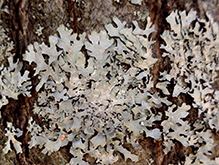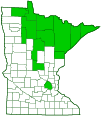Tree Lungwort
(Lobaria pulmonaria)
Conservation • Description • Ecology • Distribution • Taxonomy
Conservation Status |
|
|||||||
| IUCN Red List | not listed |
|||||||
| NatureServe | NNR - Unranked |
|||||||
| Minnesota | not listed |
|||||||
Description |
||
Tree Lungwort is a large lichen that occurs in Europe, Asia, North America and Africa. In Minnesota it occurs in the northeast and north-central regions. It is found on trees, mossy rocks, and wood in mature and old growth coniferous and deciduous forests. It grows on the bark of mostly deciduous trees, including maple, beech, ash, and oak, but also on balsam fir. It does not grow on the bark of basswood, pine, or spruce. It is sensitive to atmospheric pollution and is considered a good indicator of a rich, healthy, unpolluted forest. It is a favorite food source for moose in northeast United States. It was once thought by herbalists to be a remedy for tuberculosis because it resembles lung tissue. The vegetative body (thallus) is leaf-like (foliose), 2″ to 6″ in diameter, and divided into large lobes. The lobes are ⅜″ to 1¼″ wide, up to 2¾″ long, pale brown to olive-brown and papery when dry, bright green and leathery when wet or moist. The upper surface has a conspicuous network of ridges and depressions. The lobes are loosely attached to the substrate, often at just one end, crowded, overlapping, and hanging. On the ridges and margins there are small, roundish clusters of fungi-wrapped algal cells, some with a protective outer layer (isidia), some without (soredia). The lower surface is pale brown, blistered, and covered with fine hairs. Disk-like, spore-producing structures (apothecia) are infrequent. When present, they appear near the lobe margins. |
||
Similar Species |
||
Ecology |
||
Substrate |
||
Trees |
||
Growth Form |
||
Foliose |
||
Habitat |
||
Mature coniferous, deciduous, and mixed forests. |
||
Hosts |
||
|
||
Distribution |
||||
|
Sources |
|||
| 7/21/2022 | ||||
Occurrence |
||||
Widespread and locally common |
||||
Taxonomy |
|||
| Kingdom | Fungi (fungi) | ||
| Subkingdom | Dikarya | ||
| Phylum | Ascomycota (sac fungi) | ||
| Subphylum | Pezizomycotina (sac fungi amd lichens) | ||
| Class | Lecanoromycetes (common lichens) | ||
| Subclass | Lecanoromycetidae (shield lichens, sunburst lichens, rosette lichens, and allies) | ||
Order |
Peltigerales | ||
Suborder |
Peltigerineae | ||
Family |
Lobariaceae | ||
Genus |
Lobaria (lung lichens) | ||
| Mycobiont | Lobaria pulmonaria | ||
| Photobiont | green algae (Dictyochloropsis reticulata) blue-green algae (Nostoc) |
||
Synonyms |
|||
Sticta pulmonaria |
|||
Common Names |
|||
Lung Lichen Lungwort Tree Lungwort |
|||
Glossary
Apothecium
An open, disk-shaped or cup-shaped, reproductive structure, with spore sacs on the upper surface, that produces spores for the fungal partner of a lichen. Plural: apothecia.
Foliose
Adjective: Leaf-like growth form; referring to lichens with leaf-like growths divided into lobes.
Noun: The leaf-like, vegetative body of a lichen (thallus) that has thin, flat lobes which are free from the substrate.
Isidium
An asexual reproductive structure of a lichen in the form of a tiny outgrowth of the upper cortex. It consists of a cluster of algal cells (the photobiont) wrapped in fungal filaments (the mycobiont), and a shiny outer layer of protective tissue (cortex). Plural: isidia.
Soredium
An asexual reproductive structure of a lichen in the form of a tiny dull granule on the thallus surface that can be easily brushed off. It consists of a cluster of algal cells (the photobiont) wrapped in fungal filaments (the mycobiont), but without an outer layer of protective tissue (cortex). Plural: soredia.
Thallus
The vegetative body of a lichen composed of both the alga and the fungus. Plural: thalli.
Visitor Photos |
|||||
Share your photo of this fungus. |
|||||
| This button not working for you? Simply email us at info@MinnesotaSeasons.com. Attach one or more photos and, if you like, a caption. |
|||||
Luciearl |
|||||
 |
|||||
MinnesotaSeasons.com Photos |
|||||
|
|||||

Slideshows |
||

Visitor Videos |
|||
Share your video of this fungus. |
|||
| This button not working for you? Simply email us at info@MinnesotaSeasons.com. Attach a video, a YouTube link, or a cloud storage link. |
|||
Other Videos |
|||
| Huge lung lichens prove clean air in Bosnia´s Una National Park - 27.03.2009 wildernessresortde |
|||
About
Published on Apr 14, 2009 Do you want more information on Bosnia Today? Just visit Lichens are an integral and important component of our ecosystems. The largest biomass of lichens occurs in old-growth forests with clean air quality. Lichens possess a number of characteristics that make them suitable biomonitors for air pollution. Many lichen species have large geographical ranges, allowing study of pollution gradients over long distances. Lichen morphology does not vary with the seasons, and accumulation of pollutants can occur throughout the year. Lichens are usually very long lived. But most important: Lichens are excellent biomonitors due to their sensitivity to pollution. Due to declining population, the lung lichen (Lobaria pulmonaria) is considered to be rare or threatened in many parts of the world. The decline has been attributed to industrial forestry and air pollution, particularly acid rain. Our last trip to Bosnia unveiled the clean air in the untouched old-growth forests of Una National Park in the Northwest of Bosnia and Herzegovina. At the end of March 2009 we explored the area around Veliki Ljutoc mountain (elevation: ca. 900 m). We discovered trees looking like remnants from pre-industrial times. Beside a rich lichen flora these trees were covered by very old and huge lichen of the rare lung lichen (Lobaria pulmonaria). Intact lichen bodies (thalli) of this enormous size have just survived where for decades neither air pollution nor forestry afflicted the forests. In Germany lung lichen of this size vanished a very long time ago. Thanks to Mag. Dr. Bilovitz (Institute of Plant Sciences Karl-Franzens-University Graz, Austria) and Prof. Dr. Türk (FB Organismische Biologie Universität Salzburg, Austria), who determined samples of collected lichen, we have the proof that Lobaria amplissima is growing on this tree too. Lobaria amplissima is one of the most threatened lichen species all over central Europe, and is cited in most Red Lists as either extinct or critically endangered (e.g. TÜRK & HAFELLNER 1999, WIRTH et al. 1996). Before 1900, it was rather widespread in Germany, and was known from over half of the Federal States. In the 20th century, it has only been found in the southernmost regions of Baden-Württemberg and Bavaria, and since 1975 it has disappeared from many localities, including the last known one in Bavaria. The reasons for the decline of this and other Lobarion species have been thoroughly investigated, as this is the most threatened lichen element throughout (APTROOT & ZIELMAN - Herzogia 17/2004). Air pollution by sulphur dioxide has unquestionably had a harmful effect, but changes in forest management are often also provided as explanation. Recent research has shifted towards population studies, as individuals of the Lobaria species, and especially Lobaria amplissima, are thought to be long-lived (in the order of a century and more), as can be deduced from the often large thalli and the minimal yearly radial growth. In general, habitat continuity seems to be a prerogative for the survival of Lobarion species. |
|||
| Harvesting Lungwort Lichen - Spur of the Moment video The Practical Herbalist |
|||
About
Published on Aug 28, 2017 Lungwort lichen (Lobaria pulmonaria) makes a great anti-inflammatory brew. Most people know that one must sparsely pick this slow growing lichen but when? Sue Sierralupe of The Practical Herbalist and Real Herbalism Radio gives a tip for wildcrafters. |
|||

Created: 12/29/2018
Last Updated:


